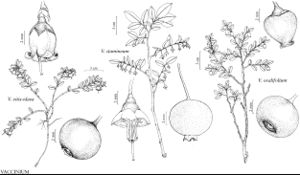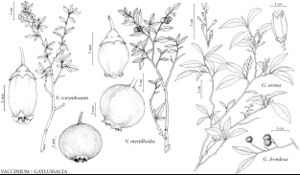Vaccinium
Sp. Pl. 1: 349. 1753.
Gen. Pl. ed. 5, 166. 1754 ,.
Subshrubs, shrubs, vines, or trees. Stems erect, spreading, or creeping, glabrous or hairy. Leaves persistent or deciduous; petiole absent or present; blade elliptic or ovate to oblong-lanceolate or spatulate, membranous to coriaceous, margins entire or serrate, plane or, sometimes, revolute, surfaces glabrous or hairy; venation brochidodromous. Inflorescences axillary or terminal, racemes, usually 2–10-flowered, sometimes flowers solitary, (leafy); (bracteoles absent, present in sect. Oxycoccos). Flowers: sepals 4–5, connate basally; petals 4–5 (–6), connate nearly their entire lengths, sometimes distinct or nearly so, white or cream to pink, bronze, or green, rarely red, corolla globose, cylindric, urceolate, or campanulate, lobes shorter to longer than tube; filaments straight, flat, glabrous or hairy, without spurs; stamens 8–10, included (sometimes exserted); anthers with or without awns, dehiscent by pores (pores laciniate in sect. Polycodium); pistil 4–5-carpellate; ovary inferior, 4–5-locular or pseudo 10-locular; stigma capitate. Fruits baccate, ovoid to globose, fleshy. Seeds 2–40, ellipsoid; testa reticulate. x = 12.
Distribution
North America, Mexico, West Indies, Central America, n South America, Europe, Asia (including Malesia)
Discussion
Species ca. 500 (25 in the flora).
The North American species of Vaccinium are distributed among ten sections. Some of these (e.g., Oxycoccus, Polycodium) have been treated as genera by recent authors, although only Oxycoccus has been recognized at genus rank widely among North American authors. Molecular data support the idea that Vaccinium is a natural genus, albeit large and diverse, provided that Oxycoccus is included.
In eastern North America, the name huckleberry is applied to species of Gaylussacia, while in western North America some species of Vaccinium are called huckleberries. Most, if not all, species of Vaccinium are edible, finding wide acceptance as fresh fruits, and for pies, preserves, etc. Some have medicinal value, especially V. macrocarpon for urinary problems. Further uses and references are noted with the individual species.
Selected References
None.
Lower Taxa
Key
| 1 | Inflorescences in axils of leaves or bracts of shoots of current season (or older shoots) | > 2 |
| 1 | Inflorescences on previous year’s shoots or on older woody stems (sometimes on new growth as well) | > 10 |
| 2 | Berries 4-locular; corollas deeply 4-lobed | > 3 |
| 2 | Berries 5-locular; corollas globose to urceolate, shallowly or scarcely lobed [45c. sect. Myrtillus] | > 4 |
| 3 | Plants erect shrubs [45a. sect. Oxycoccoides]. | Vaccinium erythrocarpum |
| 3 | Plants usually trailing vines, ascending [45c. sect. Oxycoccus (in part)]. | Vaccinium macrocarpon |
| 4 | Berries red or bluish purple and translucent; twigs angled, green | > 5 |
| 4 | Berries deep purple, purplish black, black, or blue (rarely bluish black, maroon, reddish, or red); twigs usually ± terete, sometimes angled, yellow-green, green, reddish green, reddish brown, or golden brown | > 6 |
| 5 | Shrubs colonial, 0.7-2 dm; berries 4-6 mm diam. | Vaccinium scoparium |
| 5 | Shrubs crown-forming, 10-70 dm; berries 7-10 mm diam. | Vaccinium parvifolium |
| 6 | Leaf blades with margins sharply serrate, surfaces glandular abaxially | > 7 |
| 6 | Leaf blades with portions of margins ± entire, surfaces sometimes eglandular abaxially or, rarely, glandular throughout | > 8 |
| 7 | Twigs green, angled. | Vaccinium myrtillus |
| 7 | Twigs yellow-green or reddish green, terete to slightly angled. | Vaccinium membranaceum |
| 8 | Shrubs 3-40 dm, clumped. | Vaccinium ovalifolium |
| 8 | Shrubs 0.3-15 dm, forming small clumps to extensive colonies | > 9 |
| 9 | Twigs green (sometimes glaucous), usually glabrous, rarely hairy. | Vaccinium deliciosum |
| 9 | Twigs yellow-green, reddish green, or reddish brown, finely puberulent or, rarely, glabrous. | Vaccinium cespitosum |
| 10 | Twigs not verrucose | > 11 |
| 10 | Twigs verrucose [45i. sect. Cyanococcus] | > 17 |
| 11 | Leaves usually deciduous | > 12 |
| 11 | Leaves persistent | > 14 |
| 12 | Racemes 2-4-flowered, sometimes flowers solitary, ebracteate; corollas urceolate; berries blue [45b. sect. Vaccinium]. | Vaccinium uliginosum |
| 12 | Racemes 5-17-flowered, sometimes flowers solitary, bracteate; corollas campanulate to urceolate; berries green, yellow-green, yellow, purple, or black | > 13 |
| 13 | Corollas campanulate; pedicels continuous with calyx tubes [45e. sect. Polycodium]. | Vaccinium stamineum |
| 13 | Corollas campanulate to urceolate; pedicels articulated with calyx tubes [45g. sect. Batodendron]. | Vaccinium arboreum |
| 14 | Plants usually trailing, sometimes ascending vines | > 15 |
| 14 | Plants subshrubs or shrubs | > 16 |
| 15 | Berries deep red, 4-locular; pedicels 2-3 cm [45c. sect. Oxycoccus (in part)]. | Vaccinium oxycoccos |
| 15 | Berries black, 5-locular; pedicels 0.1-0.3 cm [45h. sect. Herpothamnus]. | Vaccinium crassifolium |
| 16 | Plants rhizomatous, 0.1-3.5 dm; berries red, 4-locular [45d. sect. Vitis-idaea]. | Vaccinium vitis-idaea |
| 16 | Plants clump- or crown-forming, (3-)4-12(-40) dm; berries black or blue, 5-locular [45j. sect. Pyxothamnus]. | Vaccinium ovatum |
| 17 | Shrubs 10-50 dm; leaf blades 15-70 mm. | Vaccinium corymbosum |
| 17 | Shrubs 0.1-15 dm; leaf blades 5-62 mm | > 18 |
| 18 | Leaves persistent for 1+ years | > 19 |
| 18 | Leaves usually deciduous, rarely persistent | > 20 |
| 19 | Leaf blades glandular abaxially; twigs bright green; berries black. | Vaccinium myrsinites |
| 19 | Leaf blades glabrous abaxially; twigs pale green (glaucous); berries blue. | Vaccinium darrowii |
| 20 | Leaf blades glandular abaxially. | Vaccinium tenellum |
| 20 | Leaf blades eglandular abaxially | > 21 |
| 21 | Leaf blade margins sharply and uniformly serrate | > 22 |
| 21 | Leaf blade margins entire | > 23 |
| 22 | Shrubs 0.1-0.9 dm; leaf blades 2-6 mm wide. | Vaccinium boreale |
| 22 | Shrubs 1-3 dm; leaf blades (5-)6-16(-20) mm wide. | Vaccinium angustifolium |
| 23 | Leaf blades pale green or glaucous abaxially, surfaces usually glabrous; twigs hairy in lines or glabrous. | Vaccinium pallidum |
| 23 | Leaf blades green abaxially, surfaces densely hairy; twigs pilose or hairy | > 24 |
| 24 | Corollas and calyces glandular. | Vaccinium hirsutum |
| 24 | Corollas and calyces eglandular. | Vaccinium myrtilloides |
"entire" is not a number.


